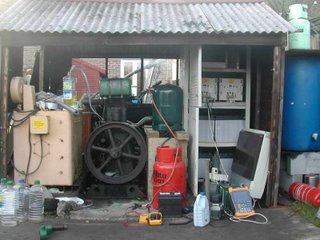
Today I have reached a milestone achievement with my waste vegetable oil generator system.
The 2nd hand emergency lighting unit that I hauled back from Wales last December is now working as a 5kW pure sine wave inverter.
That's it on the right of the photo - about the size of a single wardrobe. Two inverters units rest side by side and the bottom two shelves contain the eight 100Ah batteries.
I tried earlier in the year to get the inverter to run, but without success, solely becausse I was not giving it enough voltage. It has a special circuit that doesn't activate until it sees about 118V dc and then it springs into life. This is designed so that it won't work unless the batteries are in a good state of charge.
Likewise the inverter senses when the batteries get too low, and cuts the inverter power. This prevents the the inverter from completely flattening the battery.
The inverter is now running and producing up to 5kW of power, but the key thing is that it produces a pure sine wave at precisely 50Hz and 237V, which is essential for running modern equipment such as PCs and believe it or not, washing machines!
I now have to learn how to use the inverter to efficiently power my house. Clearly I don't need the full 5kW all the time, and at the dead of night, the house uses only about 100W keeping the fridge and freezer running.
The key to efficient use, will to run the Lister at different speeds, depending on how much demand for power is put onto the inverter. When more power is demanded, an electromagnetic solenoid will open the fuel rack to allow more power from the engine.
When idling, the engine produces about 600W of power, which is more than enough to run the house during the day, and if a heavy load is turned on, such as a kettle, the batteries take up the load for the time it takes to boil the kettle, and the engine returns to idle. In this way of working, it uses just less than half a litre of waste vegetable oil per hour, so a gallon will last about ten hours, or a complete daytime run.
Another new addition to the engine is an exhaust gas heat exchanger. A friend made this out of stainless steel for me to test. It is basically a water cooling jacket around the hot exhaust pipe, which extracts the wasted heat and uses it to heat up the domestic hot water. It will produce a full tank of hot water in just 2 hours of running.
So I am all set to take my first tentative steps to off-grid living, in the heart of Suburbia.
This weekend I expect to have completed the wiring and the change-over switch which will allow me to disconnect from the grid and over to the Lister generator.